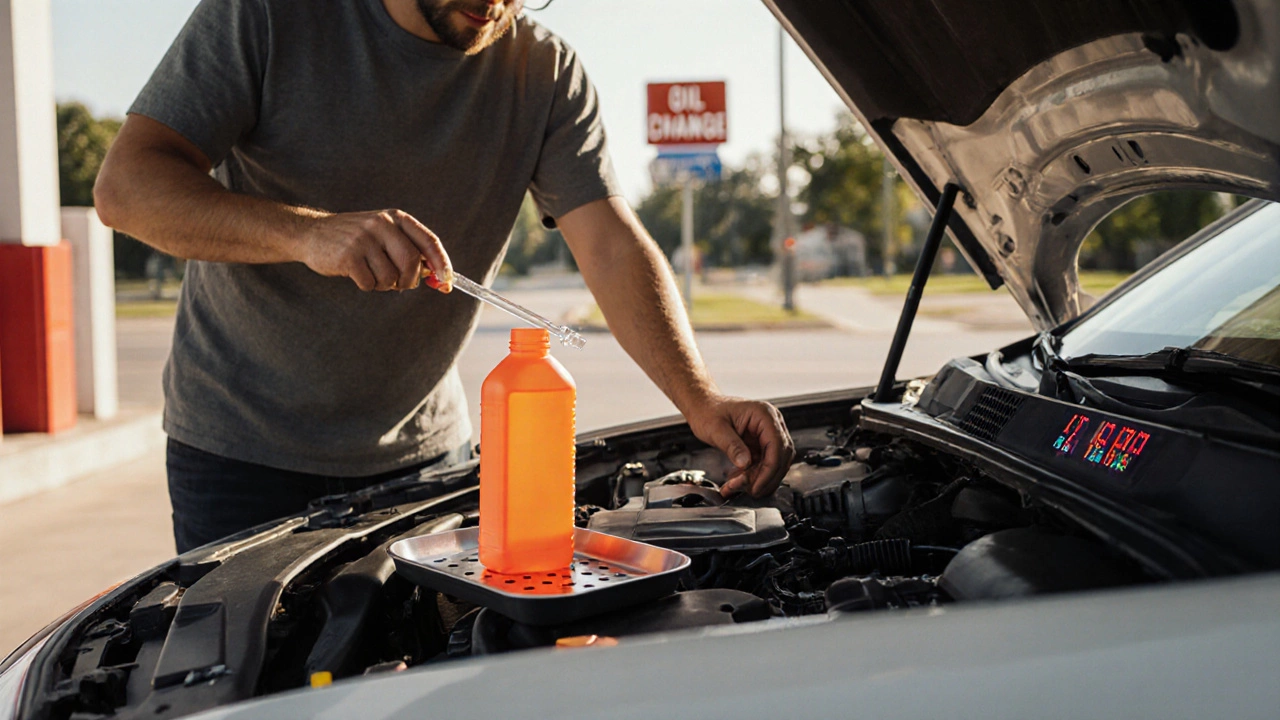Oil Change Interval: How Long Can You Skip?
 Oct, 18 2025
Oct, 18 2025
Oil Change Interval Calculator
Your Current Oil Information
Results
Key Factors Affecting Your Interval:
- --
- --
- --
When it comes to keeping a car running smoothly, the simple question of oil change interval often sparks debate. Some drivers swear by the manufacturer’s mileage recommendation, while others push the limits based on experience or cost‑saving instincts. The truth lies in a mix of chemistry, driving habits, and modern monitoring tools. Below we break down exactly how long you can go without an oil change, what factors push the deadline forward or back, and how to tell when it’s time to act.
Why Oil Changes Matter
Engine oil is a lubricating fluid that reduces friction, carries heat away from moving parts, and captures contaminants that would otherwise wear the engine. Over time it breaks down, loses viscosity, and becomes a slurry of soot, metal particles, and depleted additives. When oil can’t do its job, engine wear accelerates, fuel efficiency drops, and costly repairs become more likely.
In short, an oil change is not just a routine chore-it's a preventative health check for your engine.
Key Factors That Influence Oil Life
- Viscosity grade: Thin oils (e.g., 0W‑20) thin out faster in hot climates, while thicker grades (e.g., 5W‑30) hold up longer under stress.
- Oil type: Synthetic blends can survive higher temperatures and longer intervals than conventional mineral oils.
- Driving conditions: Stop‑and‑go city traffic, frequent short trips, and extreme temperatures accelerate oil oxidation.
- Engine load: Towing, high‑performance driving, or running the engine at high RPMs creates more heat and contaminates oil faster.
- Oil filter quality: A clogged or low‑efficiency filter lets particles circulate, shortening oil’s usable life.
- Manufacturer guidelines: Brands publish mileage or time limits based on extensive testing of their engines and recommended oil.
Typical Mileage and Time Guidelines
Most modern cars built after 2010 come with an oil life monitoring system that calculates a percentage based on driving data. When the indicator hits 15‑20 % remaining, the system usually suggests a change.
General rule‑of‑thumb figures still help when a vehicle lacks a monitor:
- Conventional mineral oil: 3,000-5,000 miles (4,800-8,000 km) or every 3 months, whichever comes first.
- Synthetic oil: 7,500-10,000 miles (12,000-16,000 km) or every 6 months.
- Synthetic blend: 5,000-7,500 miles (8,000-12,000 km) or every 4-5 months.
Time limits matter because oil degrades even when the car sits idle. Heat cycles, moisture ingress, and additive breakdown happen over months regardless of mileage.
Synthetic vs. Conventional: How Long Each Really Lasts
To see the practical difference, compare the key attributes of the two main oil families. The table below summarises the most relevant data points for everyday drivers.
| Attribute | Conventional | Synthetic |
|---|---|---|
| Typical interval (miles) | 3,000-5,000 | 7,500-10,000 |
| Typical interval (months) | 3 | 6 |
| Viscosity stability | Medium | High |
| Resistance to oxidation | Low | High |
| Cost per quart (USD) | $5-$7 | $8-$12 |
| Typical use case | Older engines, low‑stress driving | Modern engines, high‑stress or mixed conditions |
While synthetic oil costs more up front, the extended interval often means lower lifetime cost per mile, especially for drivers who rack up many kilometers.
Warning Signs You’ve Overstayed the Interval
Even the best oil can’t hide problems forever. Look for these red flags before the next scheduled service:
- Dark, gritty appearance: Fresh oil is amber and translucent; black, murky oil signals oxidation and soot buildup.
- Engine noise: Knocking or ticking can indicate insufficient lubrication.
- Oil pressure warning: Low pressure may mean oil has thinned too much.
- Excessive exhaust smoke: Blue‑tinted smoke suggests oil is burning, a sign of degradation.
- Bad smell: A burnt or acrid odor from the oil filler or dipstick points to overheating.
If any of these appear, change the oil immediately, even if the mileage or time target hasn’t been reached.

How to Monitor Oil Health Between Changes
Modern cars give you digital clues, but manual checks still add confidence:
- Check the dipstick every month or before long trips. The oil level should sit between the “min” and “max” marks, and the color should be clear amber.
- Use an oil analysis kit (available from many auto parts stores). You’ll get data on viscosity, metal content, and contaminant levels.
- Watch the oil life monitor, if equipped. Reset it after each change to keep tracking accurate.
- Consider temperature: If you live in a region where summer highs exceed 35 °C (95 °F), opt for a higher‑viscosity oil or shorten the interval by about 15 %.
These steps turn oil care from a guess into a data‑driven routine.
Practical Checklist: When to Change Your Oil
- Has your car logged the mileage range for its oil type?
- Has it been longer than the recommended months?
- Does the dipstick show dark, sludgy oil?
- Did your oil life monitor dip below 15 %?
- Are you hearing unusual engine noises or seeing a warning light?
- Are you operating in extreme heat, frequent short trips, or heavy towing?
If you answer “yes” to any of these, schedule a change now. Skipping a single interval might be okay under perfect conditions, but the risk grows quickly with each additional mile or month.
Frequently Asked Questions
Can I rely solely on the manufacturer’s mileage recommendation?
The recommendation is a safe baseline, but real‑world conditions-short trips, extreme temperatures, or heavy loads-can shorten oil life. Use it as a starting point, then adjust based on your driving habits and any oil‑life monitoring data.
Is it okay to mix synthetic and conventional oil?
Mixing is technically possible, but it defeats the performance benefits of full‑synthetic formulations. If you’re switching, fully drain the old oil and replace it with the new type to avoid unpredictable viscosity.
How often should I replace the oil filter?
Replace the filter at every oil change. A fresh filter ensures that contaminants captured during the previous interval don’t re‑enter the engine when you’re already on a new batch of oil.
Do high‑performance cars need more frequent oil changes?
Yes. Sports and turbocharged engines run hotter and at higher RPMs, which accelerates oil oxidation. Manufacturers often recommend 5,000‑mile intervals for synthetic oil, but many enthusiasts stick to 3,000‑mile changes for extra peace of mind.
Can I extend the interval by using a higher‑viscosity oil?
Higher viscosity oils resist thinning in hot conditions, but they don’t stop additive breakdown. They might help in very hot climates, yet you’ll still need to change at the recommended mileage or time limit.
Understanding the science behind oil degradation and matching it to your driving reality lets you stay safe, save money, and avoid surprise engine repairs. Whether you drive a city commuter or a weekend track car, the right oil change interval is the single most effective maintenance habit you can adopt.